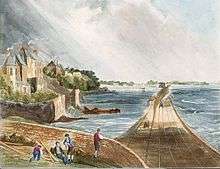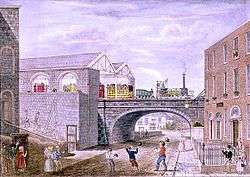John Harris Jr. (artist)

John Harris Jr. (17 November 1791 – 28 December 1873), was an English artist who specialised in pen-and-ink facsimile work,[1][2] and Masonic catechetical designs.[3]
His father was John Harris (1767–1832), the watercolour painter.[4] His son, also John Harris, continued his work after Harris himself became incapacitated, and after his death.
Facsimiles
Harris earned his income as an artist chiefly from the production of facsimiles, used to replace pages (or entire sections) of books which had been damaged or become decayed. Harris himself suggested that the process of replacing damaged pages with facsimile reproductions was first popularised by George Spencer, 2nd Earl Spencer, who commissioned such work through Harris's employer, John Whittaker.[1]
Tracing boards
Harris became a Freemason in 1818,[5] at a time when the United Grand Lodge of England was encouraging all masonic lodges to move from Tracing boards chalked on the floor, or painted onto cloths, towards permanent painted and framed boards, displayed in lodge rooms. Harris quickly became fascinated by masonic tracing boards, and painted large numbers of boards for each of the three degrees of Freemasonry, in multiple different designs.[3] Many of his boards remain extant, and Harris made a significant income from designing and selling the boards. In 1823 he dedicated a set of miniature tracing boards to Prince Augustus Frederick, Duke of Sussex, the Grand Master of the United Grand Lodge, which further enhanced his reputation.[5]
In 1845 the Emulation Lodge of Improvement ran a competition for the design of a standardised set of tracing boards, to be recommended for use in all lodges. Harris submitted designs for all three degrees, and was the immediate winner of the competition. He made slight alterations, and issued a revised form of the designs in 1849, and these "Emulation" tracing boards are today considered a definitive design in much of the English-speaking world of Regular Masonic jurisdictions.[6] The enormous original boards are still in use by the Emulation Lodge of Improvement, and may be viewed weekly, although they are sealed in protective glass cases.[6] Harris's original proof designs for the Emulation boards, and several other designs, are all today in the possession of the Sussex Masonic Museum in Brighton.[5]
Private life

Harris was married in 1820.[1] He and his wife, Mary, had eight children, five of whom died in infancy. Two sons and a daughter survived to adulthood. Their son, also named John Harris, shared in his father's artistic work.
Harris suffered poor health in his advancing years. He began to loose his sight, and in 1856 or 1857 became completely blind.[1] He also suffered a stroke at about the same time, and was severely paralysed.[3] Unable to work, Harris became impoverished, but was supported by the masonic charitable foundations, chiefly the Asylum for Worthy, Aged, and Decayed Freemasons, which became part of the later Royal Masonic Benevolent Institution (RMBI). Harris and his wife lived in the RMBI residential home at East Croydon, where he died on 28 December 1873. He was buried in Queen's Road Cemetery, Croydon, where his wife was later also interred.
References
- 1 2 3 4 Takamiya, Toshiyuki. "John Harris the Pen-and-Ink Facsimilist". Keio University.
- ↑ artfact.com, John (1791) Harris (1791-1873)
- 1 2 3 "The Tracing Boards of John Harris: A Masonic Legacy". Universal Freemasonry. Retrieved 20 August 2018.
- ↑ Freeman, Janet Ing. Oxford Dictionary of National Biography (online ed.). Oxford University Press. doi:10.1093/ref:odnb/37514. (Subscription or UK public library membership required.)
- 1 2 3 Beresiner, Yasha. "The Masonic Museum In Brighton". Freemasonry Today. Retrieved 20 August 2018.
- 1 2 Beresiner, Yasha. "Masonic Tracing Boards". Pietre-Stones. Retrieved 20 August 2018.
External links
| Wikimedia Commons has media related to John Harris Jr. (1791-1873). |